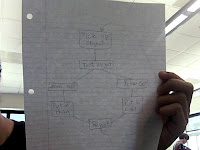 Apparently the 40-50 degree range would get you the furthest, but when you get to the extremes it starts going to high or not high enough to get some serious distance.
Apparently the 40-50 degree range would get you the furthest, but when you get to the extremes it starts going to high or not high enough to get some serious distance.Chief Master Engineer in charge of everyone
Tuesday, May 31, 2011
Ping Pong Launcher
 Apparently the 40-50 degree range would get you the furthest, but when you get to the extremes it starts going to high or not high enough to get some serious distance.
Apparently the 40-50 degree range would get you the furthest, but when you get to the extremes it starts going to high or not high enough to get some serious distance.Thursday, March 3, 2011
RoBO Pro: Subprograms and Meters
 Again I apologize for the crude nature of my program.
Again I apologize for the crude nature of my program. -The challenge was to create a master program that encapsulates our previous program to make it easier to use and less time consuming to create.
-What are the benefits of using subprograms within your team development projects?
The subprograms allow you to create a main program a lot faster and easier because you don't have to go through all the complicated processes that the original program would make you have. Instead of several variable here and there and all over the place, you can consolidate them all in a combination of subprograms.
RoBo Pro: Variables and Branch Functions


-Kody and I did the first project which was the start/finish line. We attempted to create a machine that would record the time it would take the "runner" to go from start to finish and beep once he crossed the finish line. Once the "runner" crossed the wires to the bar would send an electrical current from the creation of a circuit and causing the beeper to go off. We had some initial designs and other graphics but I lost them and don't remember how they were drawn out.
1. What was the most difficult part of the problem?
2. List and describe two features that were not part of the design problem that could be added to improve your design.
2. List and describe two features that were not part of the design problem that could be added to improve your design.
1. The most difficult part of the problem was figuring out how to set up the wiring for the electronics that we were using.
2. We could have added a multiply stop watch counter so that we could have more than two "runners" at a time and it would count the time it would take for each one instead of just the first. Also, we could have added a camera that would automatically flash when the connection was made to catch who made the beep first, if it was a close race.
Flowcharting

-How is flowcharting similar to using a map to plan a route for a trip?
Flowcharting is like using a map because you label and "map" out the route of what your supposed to do.
-Describe a process you do everyday.
In the morning, I get up, go straight to my dresser, get some boxers, go to the shower, get out, put some clothes on, then go to school. This happens every day except saturdays and sundays.
Wednesday, March 2, 2011
3.1.1 Activity
5. 0, not present, no check
6. one, present, check7. switches outcomes of 5 and 6
9. 38 to 5000
11. 1756
12. 1632
14. the red and black wires get switched
15. the reed switch is turned on by electromagnet
16. normally closed
18. photo-resistor closed makes the light shine
19. more light means more resistance in the photo-transistor
20. reverse programming
21. leave alone
Conclusion:
1. Examine the wire diagram on the mini switch and describe how the diagram relates to the concepts of normally open and normally closed.
2. If computers only understand digital signals, then how is a computer able to interpret the analog signals coming from the interface?
3. Why does resistance decrease as the NTC Resistor becomes warmer?
1. It shows the difference between normally open and normally closed switches based on whether or not the metal touches and the switch creates a circuit or doesn't.
2. A computer understands analog signals by utilizing an A/D converter.
3. It gets warmer as the electricity flows through more freely and faster because it can move through more quickly.
Tuesday, March 1, 2011
Systeme International Units
Subscribe to:
Posts (Atom)

